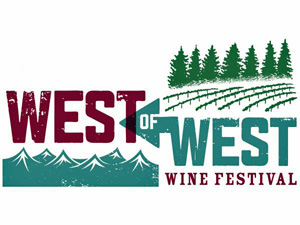Alma Fria
Alma Fria is a fairly new project started by the Holtermann family, noted for wine importing. In 2012 they purchased a small vineyard just north of Annapolis that’s planted to Chardonnay and Pinot Noir. They also source fruit from Marimar Estate’s Doña Margarita Vineyard between Freestone and Occidental, and from other vineyards as well. Red Car’s Carroll Kemp makes the wines. Proprietor Jan Holtermann was behind the winery table again this year, and he poured me five wines – 2013 Sonoma Coast Chardonnay, 2013 Sonoma Coast Pinot, 2013 Doña Margarita Vineyard Pinot, 2012 Doña Margarita Vineyard Pinot, and 2013 Holtermann Vineyard Pinot. The Chardonnay was sourced from two vineyards and made in older oak with partial malolactic fermentation. I liked the 2012 vintage of this wine last year, and this new 2013 release was even better, with pear, citrus, and floral aromas and bright, fresh mouthfeel and finish. The three 2013 Pinots each presented a distinct character. The Sonoma Coast bottling, sourced from vineyards in both the Freestone and Annapolis areas, featured red fruit, vibrant acidity, and an elegant texture. The Doña Margarita Pinot had more of a black cherry and plum fruit profile plus savory notes and a richer texture. Jan poured me a 2012 vintage of the same wine that showed how a bit of bottle age had tamed the youthful boldness into something more subtle and complex. The Holtermann Vineyard Pinot was my favorite of the 2013s. It showed more earth, tea leaf, and stony mineral notes along with black cherry fruit, with a silky texture and fine, slightly chalky tannins. Alma Fria continues to be a new label to watch.
Baker Lane Vineyards
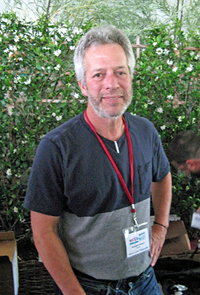 |
Baker Lane was launched by former restaurateur and wine retailer Stephen Singer with wines from the 2004 vintage. Fruit comes mostly from the estate vineyard in a very cool-climate spot near Sebastopol and from nearby Ramondo Vineyard, which Baker Lane leases and farms. Noted viticulturist and vintner Greg Adams oversees both the farming and winemaking. The label focuses on Pinot Noir, Syrah, Rosé, and a fairly recent addition to the line-up, an estate-grown Viognier. Stephen poured five of his wines for me – 2014 Estate Viognier, 2012 Sonoma Coast Rosé, 2012 Estate “Reserve” Pinot, 2012 “Sonoma Coast Cuvée” Syrah, and 2010 Estate Syrah. Baker Lane makes a very fine cool-climate Viognier – barrel fermented with no malolactic fermentation, the 2014 vintage showed bright citrus and stone fruit aromas plus a spicy note, medium bodied with a crisp mouthfeel and finish. They also make a consistently good Rosé, mostly from Ramondo Vineyard Syrah farmed specifically for this wine. Cherry, strawberry, flowers, and herbs on the nose with mouth-watering acidity in the mouth, one of the best Rosés at the tasting. Although the Pinot and “Sonoma Coast Cuvée” Syrah were both quite nice, the Estate Syrah was another standout, with black fruits, herbs, smoke, pepper, and floral undertones. Moderately big but lively on the palate, with good structure for more time in the cellar. Though they seem to fly under the radar of many wine consumers, Baker Lane has consistently delivered the goods over the years and is worthy of attention.
Ceritas Wines
John Raytek and his wife Phoebe Bass founded Ceritas in 2005, and the focus has been mainly on Sonoma Coast Chardonnay and Pinot Noir. John has worked with Rhys, Copain, and Flowers in the past. Phoebe’s family owns Porter-Bass Vineyard, located near Forestville. All of the vineyards Ceritas sourced from are farmed organically or biodynamically. The wines undergo native fermentations (Pinots are generally fermented with 35%-75% whole clusters) and are made in older cooperage. I tried four Ceritas wines at the event – 2013 “Marena” Chardonnay, 2013 Porter-Bass Vineyard Chardonnay, 2013 Elliot Vineyard Pinot, and 2013 Hellenthal Vineyard “Old Shop Block” Pinot. The “Marena” is the first Ceritas Chardonnay that’s not a vineyard-designate – it’s sourced from younger vines at Porter-Bass and Charles Heintz vineyards, and displayed pleasant stone fruit and earth aromas, with bright acidity and a fresh finish. The Porter-Bass Chard, from Old Wente clone fruit, was more intense, with a bigger texture but retaining fine acidity and a clean finish. The Pinots – from two vineyards in the Fort Ross-Seaview area – were good, with the Hellenthal being my favorite of the two. With plenty of fruit plus an herbal, savory component and earthy, mushroomy undertones, this had great structure with fine tannins. I’ve come to expect excellent wines from Ceritas and these recent releases did not disappoint.
Charles Heintz Vineyards & Winery
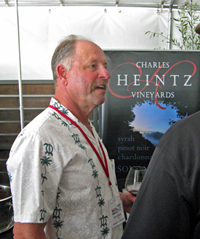 |
Charles Heintz Vineyard has been a source of fruit for many notable wineries – over 20 producers currently buy fruit from there. Just six miles from Bodega Bay, the 50-acre vineyard is part of Heintz Ranch, owned by the family for over 100 years. The vineyard includes Chardonnay, Pinot Noir, and Syrah, with the first plantings dating back to 1982. Owner Charlie Heintz has also has his own label for a number of years (along with the more value-priced Dutch Bill Creek label). All of the fruit for the wines poured at the event was sourced from the estate vineyards with the exception of the Searby Vineyard Chardonnay. Noted vintner Hugh Chappelle has been the consulting winemaker since 2012 – both Hugh and Charlie were on hand to pour their wines at the event. I tasted five wines at the Charles Heintz table – 2013 Searby Vineyard Chardonnay, 2013 “Rachael” Estate Chardonnay, 2013 “Valentina” Estate Pinot, 2013 “Swan” Estate Pinot, and 2013 “Roxy” Estate Syrah. The “Rachael” bottling was my favorite of the two Chards, and I felt it was one of the standouts of the tasting. Made in mostly neutral oak, it featured citrus, flowers, and earth while balancing a creamy texture with bright acidity. The “Valentina” Pinot was fruit-forward with cherry and spice notes, while the “Swan” was more complex, with a darker fruit profile, plus a more earthy and savory character. Finally, the terrific “Roxy” Syrah showed great purity of dark fruit along with flowers, herbs, and a stony mineral note. I thought the new wines made by Hugh Chappelle were a noticeable step up from the Heintz wines I’d tried a few years ago – this certainly looks like a label that has regained its footing and is on the way up.
Failla Wines
Originally called Failla Jordan, the winery was founded in 1998 by winemaker Ehren Jordan and his wife Anne-Marie Failla. Their first Pinot was a Keefer Ranch bottling from the 1999 vintage, and Chardonnay followed shortly afterwards. They first planted their estate vineyard in 1998 – it’s located on the far Sonoma Coast not far from Marcassin, Flowers, and Hirsch in the Fort Ross-Seaview AVA. Wines sourced from the Sonoma Coast have remained a core part of the Failla production over the years. I tasted four wines at the Failla table – 2013 Sonoma Coast Chardonnay, 2013 Sonoma Coast Pinot, 2013 Occidental Ridge Vineyard Pinot, and 2013 Hirsch Vineyard Pinot. Made in both oak and concrete eggs, the Chardonnay was bright with a chalky texture. All three Pinots were pleasant and quite different from one another. The Sonoma Coast bottling was fruit-forward, with cherry and rhubarb notes, while the Hirsch was herbal, savory, and structured. The Occidental Ridge bottling was my favorite of the three, with a vibrant color, aromas of flowers, earth, and orangepeel, plus a bright mouthfeel and long finish. While I didn’t feel that this group of wines on this particular day was showing quite up to the high standards Failla has set – they were certainly good but not outstanding as a whole – the winery continues to produce solid wines that are well work seeking out.
Flowers Vineyard & Winery
 |
Walt and Joan Flowers began planting Chardonnay and Pinot Noir at their remote Camp Meeting Ridge Vineyard northwest of Cazadero (in what’s now the Fort Ross-Seaview AVA) in 1991. A second estate vineyard, Sea View Ridge, was planted in 1998 to Pinot Noir plus a small block of Pinot Meunier. Flowers has hosted a number of top-notch winemakers over the year, and Dave Keatley took over in that position in 2014. Michelle Forry poured me four wines at the Flowers table – 2012 Camp Meeting Ridge Estate Chardonnay, 2012 Sea View Ridge Estate “Block 19” Pinot Meunier, 2012 Sea View Ridge Estate “Block 20” Pinot Noir, and 2011 Camp Meeting Ridge Estate “Block 11” Pinot Noir. The Chardonnay was a standout, with pear, spice, and earth components, beautifully balanced and elegant. You don’t see many varietal Pinot Meunier bottlings in California, and this one was quite spicy and herbal. The savory black cherry aromas of the “Block 20” Pinot were very appealing, with texture and structure that showed this to be a wine that should hold and build on that appeal for years to come. The “Block 11” Pinot, with 100% whole-cluster fermented Calera clone fruit, showed plenty of potential but still needs time. Overall a fine showing for the Flowers wines.
Freeman Vineyard & Winery
Established in 2001 by Ken and Akiko Freeman, the winery features a striking wine cave tunneled into the hills west of Sebastopol. Making exclusively Chardonnay and Pinot Noir, Akiko heads up the winemaking team, which includes consulting winemaker Ed Kurtzman. Freeman has two estate vineyards – Gloria Vineyard near the winery in the Green Valley area and the newer Sonoma Coast Yu-ki Vineyard located just five miles from the ocean. Akiko was behind the Freeman table when I tasted there. I had tried several Freeman wines at another event not long before West of West so I only tasted one this time, the 2013 Sonoma Coast Rosé of Pinot Noir. Made by the saignée method, this had a light salmon/pink color and featured red fruit and spice on the nose. A bit bigger mouthfeel than some of the other Rosé wines at the event, but with fine acidity and a clean finish. I should note that I’d tasted three Pinots at the earlier event and that the 2013 “Akiko’s Cuvée” Pinot was a real standout there. In retrospect, I wish I’d re-tasted the Freeman Pinots in the different context of the West of West event – they’re always elegant and distinctive.
Furthermore Pinot Noir
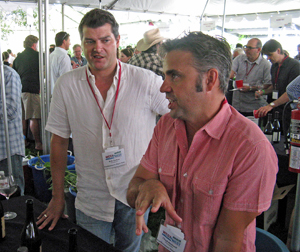 |
Launched in 2006 by Bob Zeches and Chad Richard, Furthermore produces their wines in San Francisco. The winery makes exclusively Pinot Noir, sourced from a number of vineyards in Sonoma, Mendocino, Monterey, and Santa Barbara Counties. Nevina’s is Furthermore’s new estate vineyard in the Occidental area, planted in 2002 and acquired by the winery in 2011. Bob and Chad were on hand to pour their wines at the tasting, and I tried five of them – 2013 Eden Vineyard Pinot, 2012 Gap’s Crown Vineyard Pinot, 2012 Nevina’s Vineyard Estate Pinot, 2012 Gloria Vineyard Pinot, and 2012 “Alchemy” Pinot. Chad told me that Eden Vineyard is located near Sebastopol, and the wine was bright and savory. Of the four 2012 Pinots, my favorites were the Nevina’s and Gloria (Freeman’s estate vineyard) bottlings. Both featured plenty of fruit and fine, chalky tannins, with the Nevina’s showing tea leaf and stony mineral elements while the Gloria had more spice and earth notes. The “Alchemy” Pinot is a blend from various vineyards and is meant for longer aging – it’s a bigger wine that showed more vanilla/oak at this stage but had good structure for cellaring. A fine group of wines – on the bigger end of the scale for this tasting but very tasty and nicely balanced. (Disclosure – I’ve helped bottle the Furthermore Pinots).
Gregory James Wines
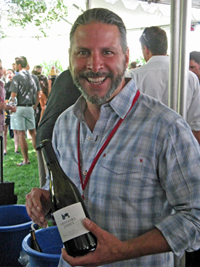 |
Gregory James is a new winery established by two friends – noted viticulturist Greg Adams and construction site developer Jim Demuth. Greg is familiar to many in Sonoma County. He has his own consulting business called Beyond the Vine, and he’s worked with many notable wineries including Stag’s Leap, Flowers, Patz & Hall, Lynmar, Red Car, and Freeman. In addition to his own new venture, he’s also the viticulturist and winemaker for Baker Lane. The first Gregory James wines are from the 2013 vintage, and the three that Greg poured at the West of West tasting are the winery’s inaugural releases – 2014 Sonoma Coast Rosé of Syrah, 2014 Patient Terrier Vineyard Chardonnay, and 2013 Hawk Hill Vineyard Pinot. The Rosé was sourced from Ramondo Vineyard from fruit grown specifically for Rosé, picked early, whole-cluster pressed, and made in neutral oak. One of the best Rosés I tasted at the event, this had bright citrus, red berry, and herb aromas with vibrant acidity and a slightly chalky finish. The Chardonnay, from Robert Young, Spring Mountain, and Old Wente selections, also showed fine acidity with a moderately creamy texture. The Pinot, from a vineyard in the Freestone area, was another standout, displaying earth, wet stone, savory herbs, and black cherry aromas along with a silky texture. A very promising debut by this new producer.
Gros Ventre Cellars
Gros Ventre was launched in 2009 by Chris and Sarah Pittenger – Chris was on hand to pour his wines at the event. Chris is also the winemaker for Skinner Vineyards in El Dorado County, where the wines are made. Gros Ventre specializes in Pinot Noir from the Sonoma Coast, Russian River Valley, and Anderson Valley. The fruit undergoes native fermentation, and most of the wines are aged for 11 months in around 17-25% new French oak. Chris poured three wines for me – 2013 Sonoma Coast Pinot, 2013 Campbell Ranch Pinot, and 2013 “First Born” Pinot. The Sonoma Coast bottling was pleasant but the other two were a definite step up. The Campbell Ranch Pinot, from a site near Annapolis, displayed focused black cherry, earth, and tea leaf aromas, with great structure and a moderately grippy finish – a serious Pinot that will need some time in the cellar. The “First Born” (a pre-release preview at the tasting) is a blend from vineyards in the Annapolis and Fort Ross-Seaview areas, and showed a more stony mineral character along with forest floor, herbs, and earth. With vibrant acidity and an elegant texture, this may be Gros Ventre’s best Pinot yet. The Gros Ventre Pinots strike a nice balance between the leaner wines of some West Sonoma Coast producers and the bigger, riper wines of others, combining bright acidity with good body and structure.
|
La Pitchoune Winery
 |
La Pitchoune is a fairly new venture run by Tracy Nielsen and Peter Joachim Nielsen. The name means “the little one” and refers to the small production and small lots of fruit that the winery works with. The first vintage was from 2012 and the wines are made in Santa Rosa by Andrew Berge, who is also the winemaker for Spell Estate. In addition to the wines I tasted, La Pitchoune also makes several other single-vineyard Chards and Pinots including ones from Pratt, Holder, and Van der Kamp vineyards. Tracy and Andrew were behind the table at the event, and they poured me four wines – 2014 Sonoma Coast Vin Gris of Pinot Noir, 2013 Sonoma Coast Chardonnay, 2013 English Hill Pinot, and 2012 Sonoma Coast Pinot. The Vin Gris featured bright red fruit, lots of spice, and a crisp texture and finish. The Chardonnay was moderately rich, with pear, lees, and vanilla/oak notes. The English Hill Pinot, from a site in the Sebastopol Hills, showed tart cherry, spice, and tea leaf aromas with good acidity. The Sonoma Coast Pinot – sourced entirely from Holder Vineyard near Occidental – was fermented with 50% whole clusters and showed more complexity than the previous wine, perhaps partly because it’s a year older. With a more savory profile to go with black cherry fruit and a touch of sweet oak, it displayed good structure for aging. I came away with the feeling that La Pitchoune is still fine-tuning its style, but with a talented winemaker like Andrew on board, I expect that we’ll see some noteworthy wines from them in the years to come.
Littorai Wines
Littorai Wines was established by Ted and Heidi Lemon in 1993. The Lemons purchased property in 2003 between Sebastopol and Freestone and completed a gravity-flow winery built with straw-bale construction there in 2008. All of the Littorai vineyards are farmed organically or biodynamically – the estate Pivot Vineyard at the winery property is part of an overall biodynamic farm there. I got to the Littorai table at the very end of the tasting, so I tasted pretty quickly and probably wasn’t able to form the best impressions of the wines, but I tried three of them – 2013 B.A. Thieriot Vineyard Chardonnay, 2013 Platt Vineyard Pinot, and 2013 Hirsch Vineyard Pinot. The Chardonnay was on the lighter side, bright and crisp with lemon and orangepeel aromas and a lively texture, quite pleasant. The Hirsch Pinot was savory and spicy with vanilla/oak notes and a tannic structure that need more time for the wine to show its best, while the Platt bottling is already showing beautifully, with pretty floral notes along with black cherry, earth, and a touch of sweet oak, finishing with fine, chalky tannins. Littorai’s wines generally age very well, and I expect that all three of these will benefit from time in the cellar. Despite my quick last-minute tasting at the Littorai table, these wines still showed well.
MacPhail Family Wines
Grower/winemaker James MacPhail launched his winery in 2002. The focus is mainly on Pinot Noir, along with some Chardonnay, and fruit sources include the Sonoma Coast, Anderson Valley and a few other regions. The 2012 vintage marked the first release of the winery’s Mardikian Estate Pinot. Located not far from Freestone, the site was planted in 2008 in a collaboration with noted grower Jim Pratt, whose own vineyard is nearby. Pinots all undergo native primary and malolactic fermentation. MacPhail’s new energy-efficient production facility is located just outside Healdsburg. I tasted two wines at the MacPhail table – 2012 Pratt Vineyard Pinot and 2013 Mardikian Estate Pinot. The Pratt, made from four Pinot clones and aged in 35% new oak, displayed riper plum fruit, spice, and vanilla/oak, with medium body on the palate. The Mardikian bottling featured six Pinot clones and showed a similar character to the first wine though with more body and structure. I’ve had some fine Pinots from MacPhail – including a terrific one I tasted not long ago from Roserock Vineyard in the Eola-Amity Hills region of Willamette Valley – but I felt the two I tried at this event were not quite up to par for the winery, at least not on that day. But MacPhail’s wines have been solid bets over the years so I’ll certainly return to them.
Peay Vineyards
Peay Vineyard is located near the town of Annapolis. The Peay label is run by the husband-and-wife team of Nick Peay, who farms the vineyard, and Vanessa Wong, who makes the wine, and by Nick’s brother Andy, who handles the marketing and sales work. The 51-acre organically-farmed estate vineyard was first planted in 1998, and includes Chardonnay, Pinot Noir, Syrah, Viognier, Marsanne, and Roussanne. Nick and Andy were behind the table for the West of West tasting, and I tried six of their wines – 2013 Estate Chardonnay, 2013 “Scallop Shelf” Estate Pinot, 2013 “Pomarium” Estate Pinot, 2009 “Pomarium” Estate Pinot, 2013 “Ama” Estate Pinot, and 2013 “La Bruma” Estate Pinot. The Peay Estate Chardonnay is a consistent standout and this was no exception, with bright apple and pear, earth, spice, and vanilla undertones with lively acidity on the palate. I preferred the more floral 2013 “Pomarium” Pinot to the earthier “Scallop Shelf” – my favorite among these two bottlings seems to change from year to year. The 2009 “Pomarium” that Nick poured showed how well these wines can age. I thought the “Ama” was the star of Peay’s fine 2013 Estate Pinots, with pretty floral aromatics along with black cherry, spice, and wet stones, along with a somewhat firmer structure that should allow it to age very well. The “La Bruma” Syrah was a terrific way to finish up – dark fruit, pepper, herbs, and a floral note, medium-full bodied with a lively mouthfeel and moderate tannins. Overall, a very impressive line-up of wines from Peay, one of the best at the tasting.
Red Car Wine Company
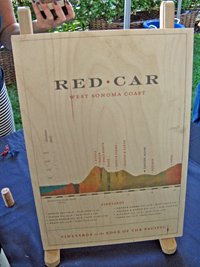 |
Red Car was established in 2000 by Carroll Kemp and Mark Estrin, who passed away in 2005. Carroll continues to head up the label and the winemaking. Red Car moved from Santa Barbara County to the Sonoma Coast in the mid-2000’s, planting an estate vineyard on King Ridge, north of Hirsch Vineyard in the Fort Ross-Seaview AVA. I tasted seven Red Car wines – 2014 Sonoma Coast Rosé of Pinot Noir, 2013 Estate Chardonnay, 2013 Estate Pinot, 2013 Hagan Vineyard Pinot, 2013 “Heaven & Earth” Pinot, 2013 Doc’s Ranch Pinot, and 2011 Estate Syrah. Red Car’s whole-cluster pressed Rosé is a consistent favorite. Sourced from five vineyards in 2014, this displayed bright strawberry and floral aromas with zippy acidity and a clean finish. The Chardonnay, from Wente clone fruit, had pear and spice upfront, lees and vanilla/oak notes in the background, medium-bodied and lively on the palate. The four Pinots all showed distinct character. The Estate bottling was more herbal, with black cherry and spice notes, while the Hagan (from a site along Occidental’s famed Taylor Lane) was more fruit-forward. The “Heaven & Earth” – from Bohemian Station Vineyard near Occidental – showed a slightly riper plum and spice character, and the Doc’s Ranch – my favorite of the four – featured a savory character along with red fruits, earth, and tea leaf, plus good structure and fine tannins. The Syrah was a standout, dark-fruited, smoky, herbal, and peppery, with a lively mouthfeel and moderate tannins. Red Car presented a strong group of wines across the board.
Senses Wines
Senses (or SENS3S, as it’s sometimes spelled) is a new project from three longtime friends – Chris Strieter, Max Thieriot, and Myles Lawrence-Briggs – with 2012 being their first vintage. The parents of Max and Myles are owners of noted Occidental-area vineyards – B.A. Thieriot Vineyard and Hillcrest Estate Vineyard respectively. Nearby Tanuda Ridge Vineyard is also a fruit source. Noted vintner Thomas Rivers Brown is the consulting winemaker. The Senses proprietors were behind their table at the event, and Chris poured me four of their current wines – 2014 Sonoma Coast Rosé of Pinot Noir, 2013 Sonoma Coast Chardonnay, 2013 Sonoma Coast Pinot, and 2013 Hillcrest Vineyard Pinot. The Rosé, from whole-cluster pressed fruit aged in older oak, featured bright red fruits and herbs, with medium-light weight in the mouth. The Chardonnay, sourced from Dutton Palms Vineyard between Graton and Occidental and aged in 20% new oak, had citrus and earth notes with a fairly smooth texture. The Sonoma Coast Pinot, from both Hillcrest and Tanuda Ridge, was savory and spicy, while the Hillcrest Vineyard bottling was a step up. With aromas of plum, orangepeel, forest floor, and stony minerals, it had great acidity and structure and a long finish with fine tannins – very attractive now and should age nicely. The early Senses wines have been a little inconsistent but have shown some promise, and the new Hillcrest Pinot is their best wine yet – hopefully a sign of things to come.
Siduri Wines
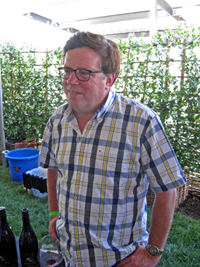 |
Established in 1994 by Adam and Dianna Lee, Siduri was a pioneer in the urban “warehouse winery” movement with their Santa Rosa facility. The Lees’ Novy label, launched in 1999, includes wines from many grape varieties, but Siduri has remained exclusively Pinot Noir from the start. Although they source Pinot fruit from various California (and Oregon) wine regions, Siduri has produced Sonoma Coast Pinots for 20 years, starting with their first Hirsch Vineyard bottling in 1995. Adam was behind the table at the tasting, and I tasted two of his wines – 2013 Sonoma Coast Pinot and 2013 Pratt Vineyard – Sexton Road Pinot. The Sonoma Coast bottling was sourced from Hirsch, Sonatera, and Pratt vineyards, and combined ripe black cherry fruit with good acidity and a tasty finish. The Pratt Pinot, from Jackson 9, Pommard, and 777 clones, was a step up, with savory, earthy notes to go with cherry and raspberry fruit. This displayed fine acidity and structure, with fine tannins – pleasant now but age-worthy too. Unlike many of the producers at West of West, Siduri is not known primarily for its Sonoma Coast bottlings, but those wines have been cornerstones of their varied line-up and continue to be among their best.
Small Vines Wines
 |
Paul and Kathryn Sloan established their Small Vines Viticulture business in 1998, developing and farming high-density planted vineyards in the Russian River Valley and Sonoma Coast. They released the first Small Vines Wines Pinot from the 2005 vintage, and Byron Kosuge has been the consulting winemaker since 2010. 2011 marked the first harvest of the Small Vines estate Barlow Homestead Vineyard near Sebastopol. Paul poured me three wines at the tasting – 2013 Sonoma Coast Chardonnay, 2013 Sonoma Coast Pinot, and 2013 MK Vineyard Pinot. The Chardonnay was sourced from younger Wente clone vines at the Barlow Homestead Vineyard, planted by Small Vines in 2009 and organically-farmed. Made in 10% new French oak, 10% stainless steel, and 80% older oak, this had bright pear, citrus, floral, and herbal aromas with a vibrant texture and finish. The Sonoma Coast Pinot was bright and red-fruited with forest floor undertones. Small Vines planted MK Vineyard in 1999 near Occidental and it’s organically-farmed. The MK Pinot showed more intense and focused black cherry fruit, with herbs, earth, and a touch of oak in the background, and had a bolder structure with fine tannins. This wine has been one of my favorites at this event in the past, and the 2013 vintage is another winner. Small Vines has been a consistently good producer of West Sonoma Coast wines and they continue to do a fine job in both the vineyard and winery.
Soliste Cellars
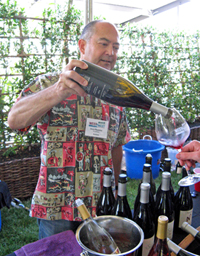 |
Soliste is the label of family friends Elisabeth & Claude Koeberle and Beth & Don Plumley. The first Soliste wine was from the 2005 vintage, a Pinot Noir from Sonatera Vineyard near Sebastopol, and most of their production has consisted of various bottlings of Pinot, plus Chardonnay and Pinot Rosé. The winery has registered a trademark for the name “MonoClone” – their single-vineyard Pinot Noirs are all made exclusively from single clones and aged in a single cooperage that are felt to work best at each of the vineyard sites. Don Plumley was on hand to pour the wines, and I tried three current releases – 2014 “Soliel Rouge” Rosé de Pinot Noir, 2012 “Forêt” Pinot, and 2013 “Narcisse” Pinot. The Rosé was a standout, showing bright and spicy citrus and red fruit aromas and a vibrant texture. Made with 50% whole-cluster press and 50% pressed after 12 hours of skin contact, it was aged in neutral oak. The “Narcisse”, unlike most of Soliste’s Pinot bottlings, is a blend of barrels from the various single-vineyard Pinots. A new release, this seemed somewhat bigger in style than most of the winery’s Pinots though still with lots of acidity – it may just need time to settle down. I preferred the “Forêt” bottling, with savory, herbal aromas along with raspberry, spice, and earth. This had a bright, elegant mouthfeel with fine tannins on the finish, and should age nicely. I’ve been impressed by the Soliste wines in the past, and this was another good showing.
Zepaltas Wines
Ryan Zepaltas (who’s also the assistant winemaker at Siduri) started his own label in 2004, focusing mostly on Chardonnay and Pinot Noir from the Sonoma Coast and Russian River Valley. He typically uses about 40-50% whole-cluster fermentation on his Pinots. As usual, Ryan was behind the table at the tasting, and I tasted three of his most recent releases – 2013 Charles Heintz Vineyard Chardonnay, 2013 DeVoto Vineyard Pinot, and 2013 Suacci Vineyard Pinot. Made in about 30% new French oak, the Chardonnay showed pear, spice, lees, and a touch of vanilla on the nose, with medium weight on the palate and a lively finish. The DeVoto Pinot, from a site west of Sebastopol, had a plum and dark berry fruit profile along with earth and tea leaf notes and a chalky texture on the finish. The standout of the Zepaltas line-up was the Suacci Vineyard Pinot. Ryan has made some terrific Pinots from this vineyard over the years and the 2013 is among the best of them. Featuring red fruits, savory herb, earth, and spice aromas, this had juicy acidity and fine tannins – this should improve in the bottle for years to come. Zepaltas wines have been consistent over the years, never flashy but solid and dependable. |


